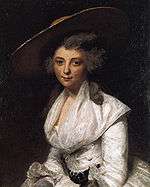Charles Bingham, 1st Earl of Lucan
Charles Bingham, 1st Earl of Lucan (22 September 1735 – 29 March 1799),[1] known as Sir Charles Bingham, 7th Baronet, from 1750 until 1776, was an Irish peer and politician.
Background
He was the second son of Sir John Bingham, 5th Baronet, and his wife Anne Vesey, daughter of Agmondesham Vesey.[2] In 1750, Bingham succeeded his older brother John as baronet.[3]
Career
Bingham was appointed High Sheriff of Mayo in 1756.[4] He was elected as Member of Parliament for both Castlebar and Mayo in 1761, and chose to sit for the latter.[5] He was returned to the Irish House of Commons until 1776,[5] when he was elevated to the Peerage of Ireland as Baron Lucan, of Castlebar in the County of Mayo.[6] As his title enabled him only to take a seat in the Irish House of Lords, Bingham was not restricted from entering the British House of Commons for Northampton in 1782, representing it until two years later.[7] In 1795, Bingham was further ennobled in the Peerage of Ireland as Earl of Lucan, of Castlebar in the County of Mayo.[8]
Family

On 25 August 1760, he married Margaret Smith, daughter of Sir James Smith, at Bath, Somerset,[4] and by her he had four daughters and a son,[2] among which:
- Richard Bingham, 2nd Earl of Lucan;
- Lady Lavinia Bingham, who married The 2nd Earl Spencer;
- Lady Anne Bingham
- Lady Margaret Lindsey; her daughter was Margaret Grey Porter
- John A. Bingham
Lord Lucan died, aged 63, at Charles Street, Mayfair, London, and was succeeded in his titles by his only son Richard.[9]
References
- "Leigh Rayment – Peerage". Retrieved 18 June 2009.
- Lodge, John (1789). Mervyn Archdall (ed.). The Peerage of Ireland or A Genealogical History of the Present Nobility of that Kingdom. vol. VII. Dublin: James Moore. p. 107.
- "Leigh Rayment – Baronetage". Retrieved 18 June 2009.
- "ThePeerage – Charles Bingham, 1st Earl of Lucan". Retrieved 18 June 2009.
- "Leigh Rayment – Irish House of Commons 1692–1800". Archived from the original on 1 June 2009.
- "No. 11679". The London Gazette. 29 June 1776. p. 1.
- "Leigh Rayment – British House of Commons, Northampton". Archived from the original on 6 October 2018. Retrieved 18 June 2009.
- "No. 13821". The London Gazette. 10 October 1795. p. 1052.
- Sylvanus, Urban (1799). The Gentleman's Magazine. part I. London: John Nichols. p. 349.
| Parliament of Ireland | ||
|---|---|---|
| Preceded by James Cuffe I Paul Annesley Gore |
Member of Parliament for Mayo 1761–1776 With: Hon. Peter Browne-Kelly 1761–68 James Cuffe II 1768–76 |
Succeeded by James Cuffe II Arthur Browne |
| Preceded by Henry Mitchell John Browne |
Member of Parliament for Castlebar 1761 With: Joshua Cooper |
Succeeded by Joshua Cooper Richard Gore |
| Parliament of Great Britain | ||
| Preceded by Viscount Althorpe George Rodney |
Member of Parliament for Northampton 1782 – 1784 With: George Rodney |
Succeeded by Lord Compton Fiennes Trotman |
| Peerage of Ireland | ||
| New creation | Earl of Lucan 1795–1799 |
Succeeded by Richard Bingham |
| Baron Lucan 1776–1799 | ||
| Baronetage of Nova Scotia | ||
| Preceded by John Bingham |
Baronet (of Castlebar) 1750–1799 |
Succeeded by Richard Bingham |